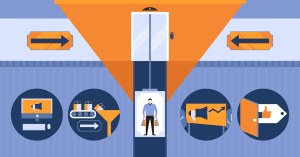There is no one-size-fits-all funnel for every sales team: They must be segmented according to a company’s customer base and sales process. However, there are definite steps in every funnel, and the AIDA Model, conceived of in 1898, breaks down the process a customer goes through during the buying process. AIDA stands for awareness, interest, desire, and action, and salespeople must be aware of each of these segments in order to help customers progress and become a customer.
When a salesperson works with a lead, there are tactics that can help even hesitant customers feel more confident in making a purchase. Salespeople who are patient with the word “no,” consistently follow-up, segment their audience, and pay attention to metrics are bound to succeed. With thorough knowledge of their company’s sales funnel, as well as the data to back up every step within the funnel, salespeople will see higher close rates with more efficient efforts. Learn more about how in the infographic below.
How to Help a Customer Transition Smoothly Through the Funnel
The AIDA Model
- What is the AIDA Model?
- Conceived in 1898
- Identifies cognitive stages an individual goes through during the buying process for a product or service
- What does AIDA stand for?
- A: Awareness
- Customer becomes aware of the product or service
- I: Interest
- Customer expresses interest in the product or service
- D: Desire
- A sense of wanting for the product or service arises
- A: Action
- Customer takes the next step toward purchasing the product or service
Does the traditional sales funnel work for every business?
- It can help identify areas that need improvement
- Without proper sales funneling, businesses do not have a clear vision of:
- Where customers drop off
- Which areas of marketing strategy they need to improve
- The ROI on marketing efforts
- Without proper sales funneling, businesses do not have a clear vision of:
- It builds relationships
- Others argue that the sales funnel can still be a powerful conversion tool by nurturing potential leads via email marketing
- Marketers compete for fractured attention spans
- 98% of website visitors leave a site without converting
- Marketers should set up a sales funnel using email marketing
- 69.7% of internet users say email is their preferred method of communicating with businesses
- Marketers should use email to engage and educate audience, guiding them from prospect to customer
- Marketers compete for fractured attention spans
- Some argue that the sales funnel model is obsolete based on the way modern shoppers educate themselves before pursuing a product
- According to Google
- 88% of consumers have already done research, consulting an average of 10+ media sources by the time marketers meet them
- According to Google
- Others argue that the sales funnel can still be a powerful conversion tool by nurturing potential leads via email marketing
- Don’t throw away “no’s” too quickly
- In a sales process, a no really means, “not until later.”
- Solution:
- Build an automated email follow up campaign that addresses their objection
- Educate the prospective client on their content problem
- Add the prospect in an educational campaign that nurtures them toward a sale
- Once the work is finished this campaign will work for you repeatedly
- Consistent follow up
- Sales can be lost due to a lack of consistent follow up.
- 48% of sales reps never follow-up with a prospect
- Only 10% of sales reps make more than 3 contacts with a prospect
- 80% of sales close between the fifth and 12th contact
- Solution is found in automation
- Automation provides reps with consistent touch points throughout the sales funnel
- This allows reps to focus on new leads and not spending hours following up
- Sales can be lost due to a lack of consistent follow up.
- Following up time
- Leads are 9 times more likely to convert if you follow up within the first 5 minutes of the prospect showing interest
- Waiting 30 minutes or more makes a lead 21 times less likely to turn into a sale
- Solution is found again in automation
- Automation allows you to set up a campaign to respond immediately
- When the lead travels down the funnel at a pre-determined moment, sales automation platform can send a personalized email
- Segment Customers
- Identify and understand your average and best customers
- Who they are
- What they need from you
- What you provide to them
- Identify and understand your average and best customers
- Assess Your Offerings
- Revisit your points of product and service differentiation
- Identify why customers choose you over your competition
- Not addressing these differences in your sales process could cause you to lose quality leads
- Lead Qualification
- The better you’re at qualifying and disqualifying leads, the more smoothly your sales funnel will flow
- What prompts within your prospect pool have you identified?
- What set of questions identifies your next sale?
- What set of questions disqualifies poor prospects?
- The better you’re at qualifying and disqualifying leads, the more smoothly your sales funnel will flow
- Adjust
- To maximize your sales efforts, adjust to your prospects’ and customers’ needs
- This may be a simple change that results in a big impact
- To maximize your sales efforts, adjust to your prospects’ and customers’ needs
- Sales Metrics Are Essential
- Your sales database and CRM tell you what is working and what isn’t
Sales Funnel Tips
Conclusion
The sales funnel is an essential aspect of any business. Build a stronger business by finding new ways to help customers transition through.



























